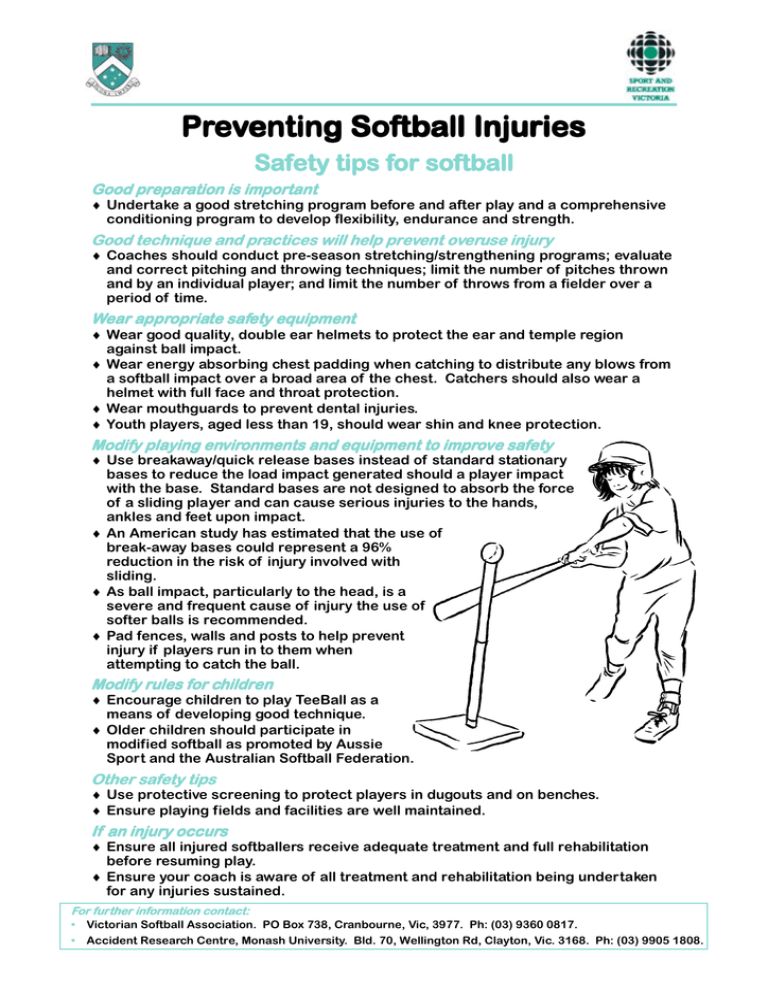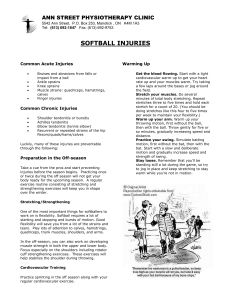Pr Preeeeevvvvventing Softball Injuries enting Softball Injuries
advertisement

Pr eventing Softball Injuries Pre Saf ety tips ffor or softball Safety Good pr epar ation is impor tant pre para important ♦ Undertake a good stretching program before and after play and a comprehensive conditioning program to develop flexibility, endurance and strength. Good tec hnique and pr actices will help pr event o ver use injury technique practices pre ov eruse ♦ Coaches should conduct pre-season stretching/strengthening programs; evaluate and correct pitching and throwing techniques; limit the number of pitches thrown and by an individual player; and limit the number of throws from a fielder over a period of time. Wear a ppr opria te saf ety equipment appr ppropria opriate safety ♦ Wear good quality, double ear helmets to protect the ear and temple region against ball impact. ♦ Wear energy absorbing chest padding when catching to distribute any blows from a softball impact over a broad area of the chest. Catchers should also wear a helmet with full face and throat protection. ♦ Wear mouthguards to prevent dental injuries. ♦ Youth players, aged less than 19, should wear shin and knee protection. Modify pla ying en vir onments and equipment to impr ove saf ety playing envir vironments impro safety ♦ Use breakaway/quick release bases instead of standard stationary bases to reduce the load impact generated should a player impact with the base. Standard bases are not designed to absorb the force of a sliding player and can cause serious injuries to the hands, ankles and feet upon impact. ♦ An American study has estimated that the use of break-away bases could represent a 96% reduction in the risk of injury involved with sliding. ♦ As ball impact, particularly to the head, is a severe and frequent cause of injury the use of softer balls is recommended. ♦ Pad fences, walls and posts to help prevent injury if players run in to them when attempting to catch the ball. Modify rrules ules ffor or c hildr en childr hildren ♦ Encourage children to play TeeBall as a means of developing good technique. ♦ Older children should participate in modified softball as promoted by Aussie Sport and the Australian Softball Federation. Other saf ety tips safety ♦ Use protective screening to protect players in dugouts and on benches. ♦ Ensure playing fields and facilities are well maintained. If an injury occur s occurs ♦ Ensure all injured softballers receive adequate treatment and full rehabilitation before resuming play. ♦ Ensure your coach is aware of all treatment and rehabilitation being undertaken for any injuries sustained. For fur ther inf orma tion contact: further informa ormation Victorian Softball Association. PO Box 738, Cranbourne, Vic, 3977. Ph: (03) 9360 0817. Accident Research Centre, Monash University. Bld. 70, Wellington Rd, Clayton, Vic. 3168. Ph: (03) 9905 1808. Pr eventing Softball Injuries Pre Facts on softball injuries How many pla yer s? play ers? ♦ In 1993 there were over 60,000 players formally registered with the Australian Softball Federation. In addition, it is estimated that a further 150,000 Australians participate in recreational softball annually. ♦ In Australia softball in predominantly played by women. How many injuries? ♦ Softball injuries rank 13th (for children) and 16th (for adults) in terms of sport and recreation injury presentations to Australian hospital emergency departments. Who is injur ed? injured? ♦ Although softballers of all ages and levels of experience are injured, females aged 10 to 19 years are the most commonly injured group of softballers in Australia. ♦ Of those injuries to softballers, 43% child and 81% of adult cases occurred during formal play. When do injuries occur? ♦ In Victoria, child injuries occur more frequently at the start of the season. In comparison, almost half of all adult injuries occur at the end of the season. The cause and type of injuries ♦ Softball injuries to children are most often associated with falls, being hit by the ball, misjudging catches, being hit by the bat and over-exerting. ♦ Softball injuries to adults are most often associated with running between bases, particularly involving sliding to base and overexerting while running between bases. Impact with standard stationary bases while sliding to base is the cause of serious hand, ankle and feet injuries. ♦ Other injuries to adults relate to catching the ball and being hit by the ball. ♦ Injuries to child softballers are predominantly to the fingers, and are mostly fractures and strains/sprains. Radius/ulna fractures and ankle strains/sprains are also common. ♦ Injuries to adult softballers are mostly strains/sprains to the ankle, knee or finger. Ref er ences efer erences Finch C, Valuri G. Pitching injury prevention to baseballers and softballers: a review of the literature. Monash University Accident Research Centre. Report No 106. November 1996. Ac knowledgments Acknowledgments Illustrations by Debbie Mourtzious, Education Resource Centre, Royal Childrens Hospital, Melbourne. This project was funded by Sport and Recreation Victoria and the Public Health Research and Development Committee of the National Health and Medical Research Council.


